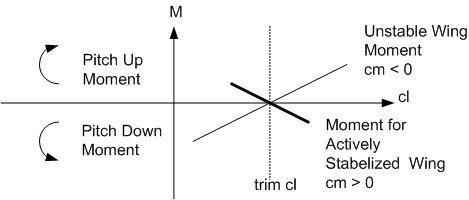Passive Pitch Stability Concepts
Passive pitch stable airplanes generate all stabilizing forces as a result of the airplane’s structural design without the need for intelligent control systems. They generally exhibit both static and dynamic passive pitch stable behavior. An airplane is said to be statically stable when it returns to trim flight attitude on its own from any small disturbances. Trim attitude is the intended steady state flight attitude or wing angle of attack where all aerodynamic forces and moments are in perfect balance. An airplane is said to be dynamically stable when it returns to and settles to trim attitude reasonable quickly without prolonged oscillations. Although dynamic stability is important, it is not absolutely necessary. Static stability, however, is vital.
Ordinarily wings designed for tailed airplanes are pitch unstable on their own. Wings designed for flying wing plank configurations, on the other hand, are pitch stable. Tailed airplanes rely on a large stabilizing pitching moment produced by a second wing, the horizontal stabilizer. The horizontal stabilizer tail volume (surface area x moment arm) has to be sufficiently large to cancel the destabilizing moments produced by the main wing. Pitching moment trends for a properly designed tailed aircraft are illustrated in Figure 1. Individual moments produced by wing and horizontal tail surfaces are plotted separately along with the combined effects (neglecting fuselage and fin contributions). As expected, a properly designed tailed airplane generates a net stabilizing pitching moment, one with a negative dM/dcl slope.
Typical flying wings come in two flavors, swept-wings and flying wing planks. Swept flying wings equipped with unstable airfoils rely on a combination of wing sweep and wing twist for static stability. The off-trim pitching moment for this type of flying wing is similar to the tailed airplane configuration. Flying wing planks use reflexed airfoils with the CG positioned forward of the mean chord aerodynamic center (c/4). Typical pitching moment plots for flying wing planks are shown in Figure 2.



